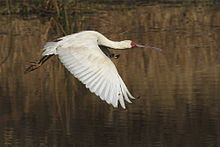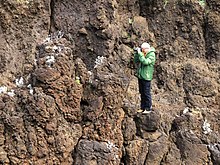Wildlife photography
The wildlife photography is a field of nature photography .
subjects
Animal photography deals with taking pictures of living animals , preferably in their natural habitat. But also recordings in the zoo or aquarium are definitely included.
The most famous competition in the field of wildlife and nature photography is the Wildlife Photographer of the Year .
technology
Most wild animals are shy and do not allow humans to get close enough to get satisfactory shots with common amateur equipment. Some, in turn, are dangerous enough that you don't choose too small a distance for your own protection. When taking pictures in zoos, fences, ditches or other circumstances are often a hindrance. Animal photography is therefore largely a domain of cameras with long to very long telephoto lenses . Exceptions are found in underwater photography and in extreme close-up photography.
For the photography of larger lizards and mammals from a safe distance z. B. for 35mm cameras and medium format cameras, telephoto lenses with focal lengths between 135 and 800 mm are necessary. Smaller animals can be photographed with standard normal lenses with focal lengths of 50 or 80 mm. Macro lenses are often used for spiders, ants, beetles, worms and living things of similar size , which allow images from 1: 1 to 1: 5 on the 35mm film or 6x6 film.
For magnifications in the range from 1:10 to 10: 1, z. B. used a reversing ring or a bellows device . For higher resolutions there are cameras and cameras that can be connected to microscopes .
Well-known wildlife photographers
See also
Web links
Individual evidence
- ↑ Heidi & Hans-Jürgen Koch. Retrieved June 4, 2014 .



